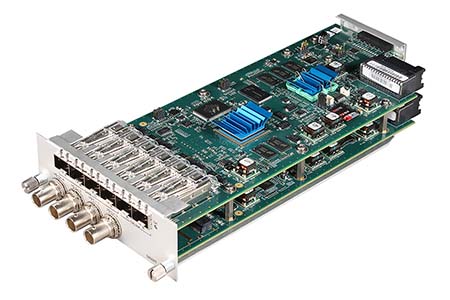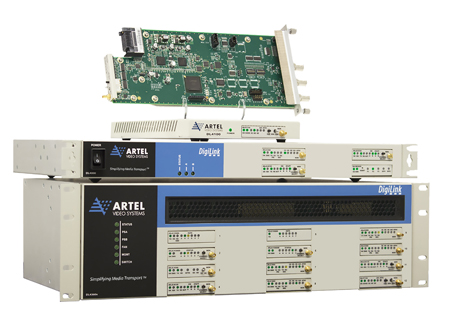It is important to design intercom into the audio-over-IP environment and have an intercom option for the mixing console when building the audio system for a facility, says Egor A. Tyagunov.
Back in the early 2000s, before the first real audio-over-IP multicast broadcast audio solutions came about, everything was on analogue or AES3. Every channel required two or three copper wires to deliver, and it was always point to point. If you needed to run one of the channels to another place, then you needed more copper in that direction. Switching channels in real time involved large and expensive switching matrices. It got even more complicated when the workflow required multiple channels in the mix at the same time, and you had to switch them to and from multiple points around the facility or from the outside world.
That complexity, coupled with high maintenance and operational costs, is one reason the industry started moving toward audio-over-IP and media-over-IP. IP networks made it possible to do multicasting. Now everything is condensed on a network switch, which takes the place of expensive switching matrices, and all signals move over the network instead of copper multicores. Every port on that switch can access content from every other available port, and we use internet protocols to send the content across the facility, the country or the globe. The whole process is much simpler, and you can do it all with basic off-the-shelf equipment that makes the network less costly to maintain.
A few years back, when broadcasters started implementing AES67 and audio-over-IP in a viable way, intercom was one of the last types of device on board. In fact, even today some vendors still offer intercom solutions that operate over analogue and AES3 cables, and not every console manufacturer includes intercom in its consoles. That means anyone who uses those products must handle intercom signals separately from the rest of the mix, which makes implementing a live broadcast more complex.
![]() There are indeed plenty of manufacturers that have moved to IP-based systems, but the communication protocol between the intercom station and the belt packs is sometimes proprietary and still requires two or four wires. The hope is that all systems in the market will eventually be compatible. But that’s for another article.
There are indeed plenty of manufacturers that have moved to IP-based systems, but the communication protocol between the intercom station and the belt packs is sometimes proprietary and still requires two or four wires. The hope is that all systems in the market will eventually be compatible. But that’s for another article.
Intercom signals are more than just behind-the-scenes crew communications, like when the producer tells the camera operator where to point the camera or cues the sound engineer to send the mix for a particular part of the broadcast. Intercom can be content as well, such as voiceover or translation. It is an integral part of the whole production, which is why it should be treated the same as the main audio essence. When you must integrate such content into the audio mix in real time, it pays to have intercom as part of the IP production network.
Suppose you have an old intercom system that can talk to 50 people but is technically unable to accommodate all 50 inputs and 50 outputs on the final feeds. That means you have to condense all the signals into maybe five analogue or AES3 inputs and five outputs, or 10 and 10, which can become a complicated task. Of course you can create groups or party lines, joining teams of people together as one communication node, and not all of them need to be a source to the outside. But with a modern intercom system built for audio-over-IP, each source can be one point in network space, and you simply talk to this source in the network wherever you want. You can choose which voice, which back-feed of content or which part of the content you want to listen to.
Do you want to hear that particular side of the stadium? You can do it. Do you want to speak to that group of camera operators or join them together? No problem! Do you want to listen to the whole mix? Done. And you can do it all today with a virtual console or software intercom control panel (though physical devices still exist).
With intercom on the IP network, integrating intercom signals into the production is much more convenient. All you have to do is put a certain multicast IP source or audio channel in a certain video channel. The voice could be located anywhere with access to the network, whether on the other side of the facility or the other side of the world. You can also have any AoIP source as the intercom back-feed to the voiceover artist, making it easier to direct and guide the speaker throughout the programme. It can be done in the same channel, with audio-over-IP as the controls, notifications, on-air lights, etc.
A few things to make it happen: Channel count and network capacity
The number one thing to consider is how many people you must listen to and communicate with, which will determine how many channels you need. Basically, every person will become an audio channel and might need feedback audio or IFB, so you must be sure that you have the network capacity and the switching capability to handle them all, with some headroom for the future. In the process, you must be able to communicate with other networks too, such as when you gateway your intercom network into the audio-mixing network and to wherever the mixers and engineers embed the audio into the video. Think of clocking and sync in the network for both audio and video. IEEE1588 PTPv2 timing is important to rely on here. Certain modern switches can help too.
Plan for redundancy – Maybe extra connectivity to the outside world with remote branches or talent, an extra switch so you can create a completely independent delivery network for your audio signals, or extra electrical power to run the facility and extra PoE capacity. Consider a monitoring system that will help spot problems before they go too far and can even automatically switch to backup, avoiding any interruptions.
Future-proofing – A true AES-67- based audio-over-IP system is futureproof. Even if your video side still runs on SDI, an audio-over-IP network will integrate seamlessly whenever your facility moves to video-over-IP systems such as SMPTE ST 2110.
Expert advice – Get input from a good media networking technologist during the design stage. Without an expert you can end up paying much more than expected, because you might have to buy a new system sooner than planned or correct everything that has been done wrong.
Conclusion
Media-over-IP is the future and will still be functional even as technology evolves in the coming decades. With the current trend of virtualisation – where devices from the past become servers (physical or virtual) and all types of content become real-time data streams moving between them – audio-over-IP, including intercom, is a significant and very important part of this future-proof technology, which means you should invest no less in audio than in video.
![]() Egor A. Tyagunov is Director of Business Development, EMEA at Artel.
Egor A. Tyagunov is Director of Business Development, EMEA at Artel.











































































